Explore a wild environment and discover Berber heritage, as rich as fascinating. From their legendary stories to a trip to the heart of Sahara, follow the path traced by our editor.
They have been populating North Africa since the night of time: they are the “Imazighen”, the Free Men. You may know them as Berbers: this is how they were appointed by the Roman Empire, to which they belonged for centuries. For the invasions, wars and other colonizations punctuated the existence of Berbers! Yet this gigantic community and its mosaic of tribes have managed to preserve their traditions, their folklores and their cultures to celebrate them again today.
Let us lie together in the history of Berbers and their anchorage with the Sahara thanks to a road trip in the south-east of Morocco. From the beginning of Marrakech to the dunes of Chegaga, I will take you through the High Atlas, an ancestral land of the Moroccan Berbers, to lift the veil on the amazigh heritage as rich as unknown.
On the trace of the Imazighen...
First occupants of North Africa
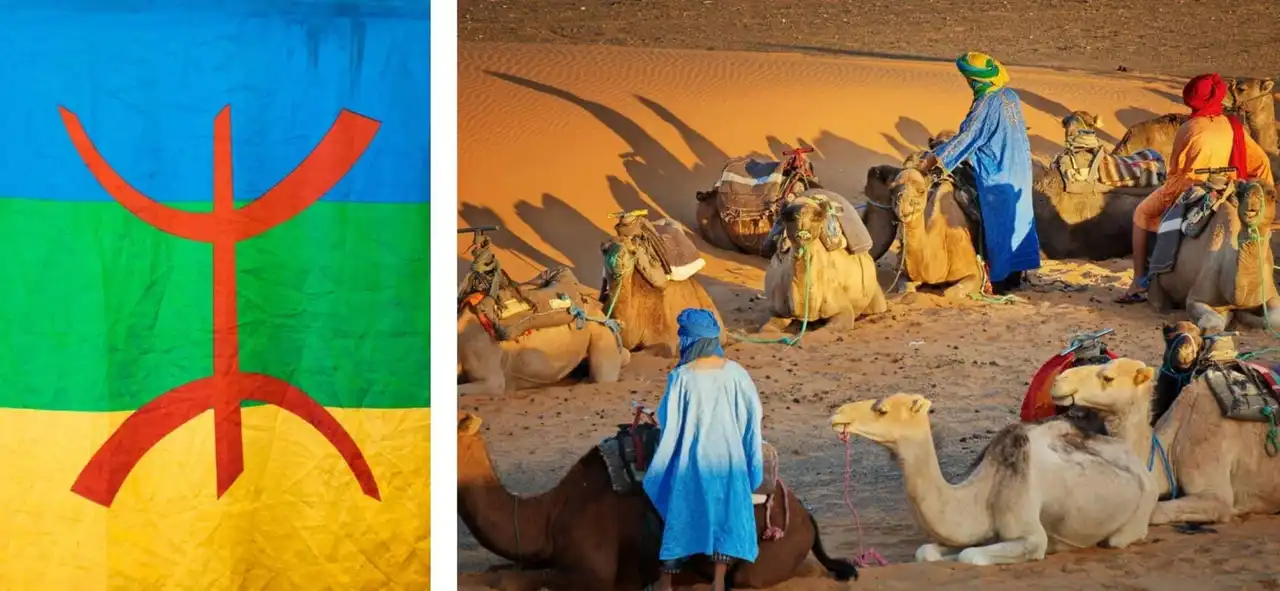
Flag Amazigh – Photo credits: Shutterstock – matias planas & Dan Baciu
The waves of Arab and Western colonization, including French, often forget that North Africa is historically the land of Berber peoples. Indeed, they would be the first occupants of the Maghreb, those who will find concrete traces with primitive art and writing in the first half of the first millennium before our era.
In addition, archaeologists will find rock paintings identified as Berbers on the walls of the mountainous massif of Tassili n’Ajjer, between Libya and Libya Algeria where there are still Tuareg tribes. These paintings highlight the beliefs of Berbers, carried on nature, the relationship to sun and moon, and the sacred power of rocks.
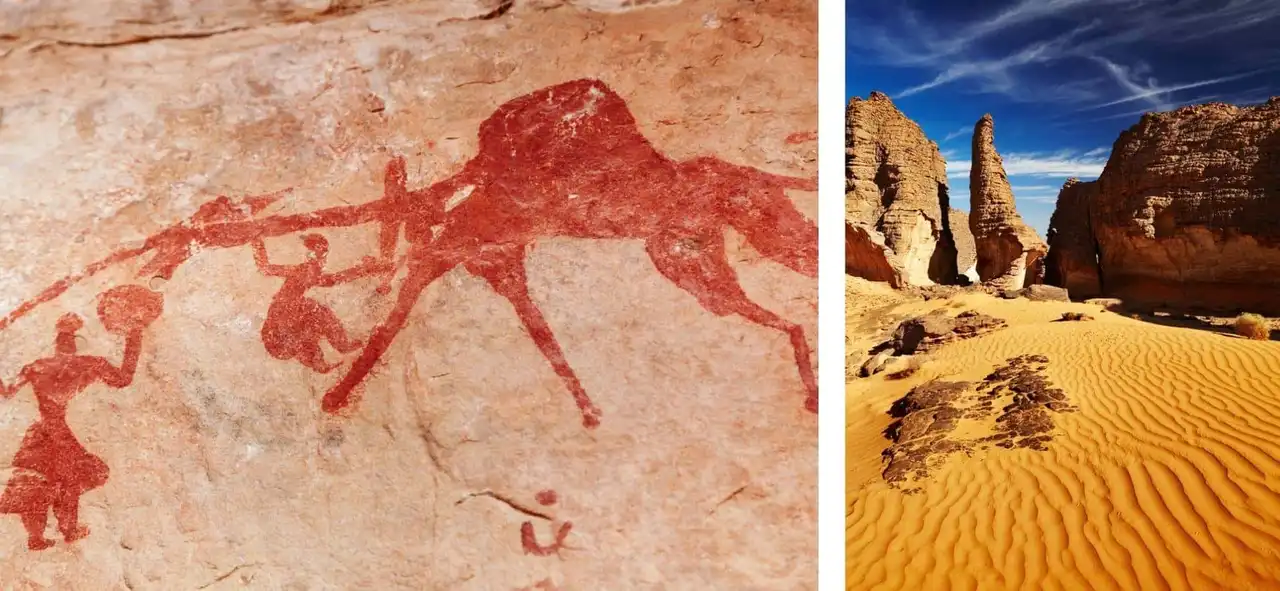
Prehistoric painting in Tassili N’Ajjer’s desert of Tassili N’Ajjer – Photo credits: Shutterstock – Dmitry Pichugin
As for the Berber language "Tamazight", gathering several dialects, it dates from 2,000 BC. It was spoken in many parts of the Maghreb, to the Nile valley.
Great civilizations and Berber dynasties
The Berber peoples of North Africa live at the pace of the great empires and civilizations. This begins with the Capsian civilization between -9000 and -7000 BC, followed by the Carthaginian civilization.
Thus, Berbers cohabit the Phoenicians, or the Spanish Iberians. It is in Antiquity, in the third century before our era, that the largest Berber kingdom emerges: the Numidia, currently Algeria, with Cirta as capital (now Constantine). She is then an ally of the Romans against Carthage, even extending her power to the present. Tunisia . Berber culture will also have a real influence on the art and lifestyle of the Romans! Subsequently, an addition of conflicts shared the Numidia, and Berbers therefore adapted to new governance.
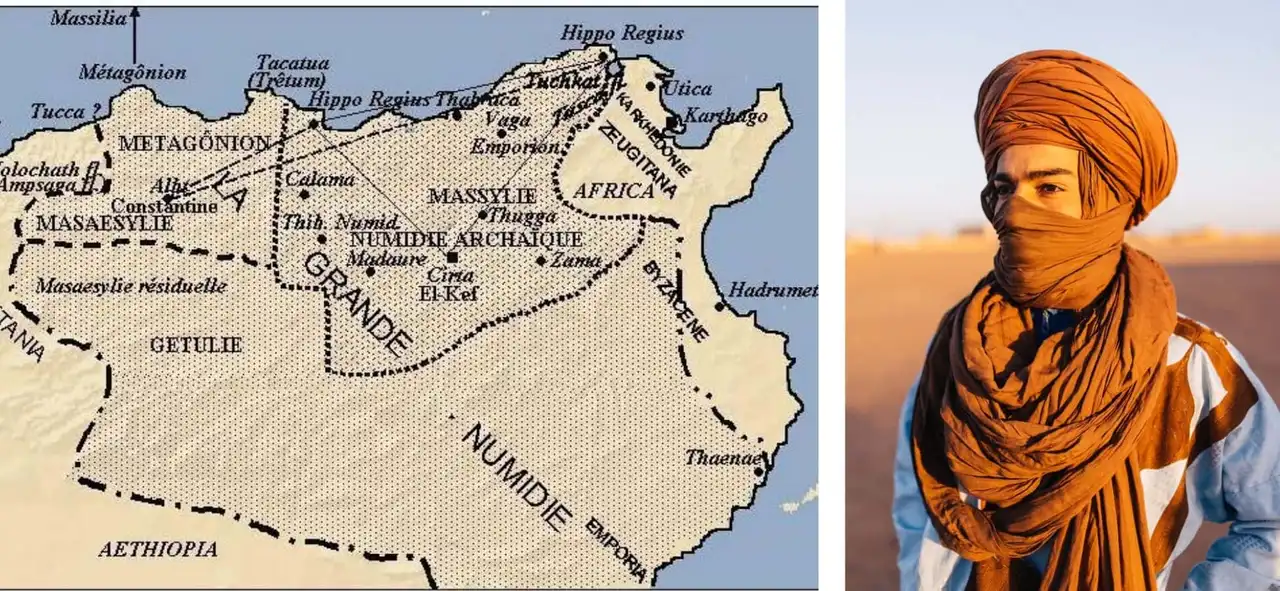
Map of the Numidie, Berber in the Sahara – Photo credits: Wikipedia – Mohamed Tlili & Shutterstock – Jake Hateley
However, it is the Muslim Conquest of the Maghreb around 647 which represents a major change for the Berber populations of North Africa. The latter, Catholics, Jews or Gentiles, then convert to the Muslim religion, when others try to maintain their own worships.
It will have to wait several centuries for several large Berber dynasties to succeed in power, among them the Zirides in Algeria, the Almoravids, the Merinides and the Almohades in Morocco. These are at the origin of the Hassan Tower of Rabat!
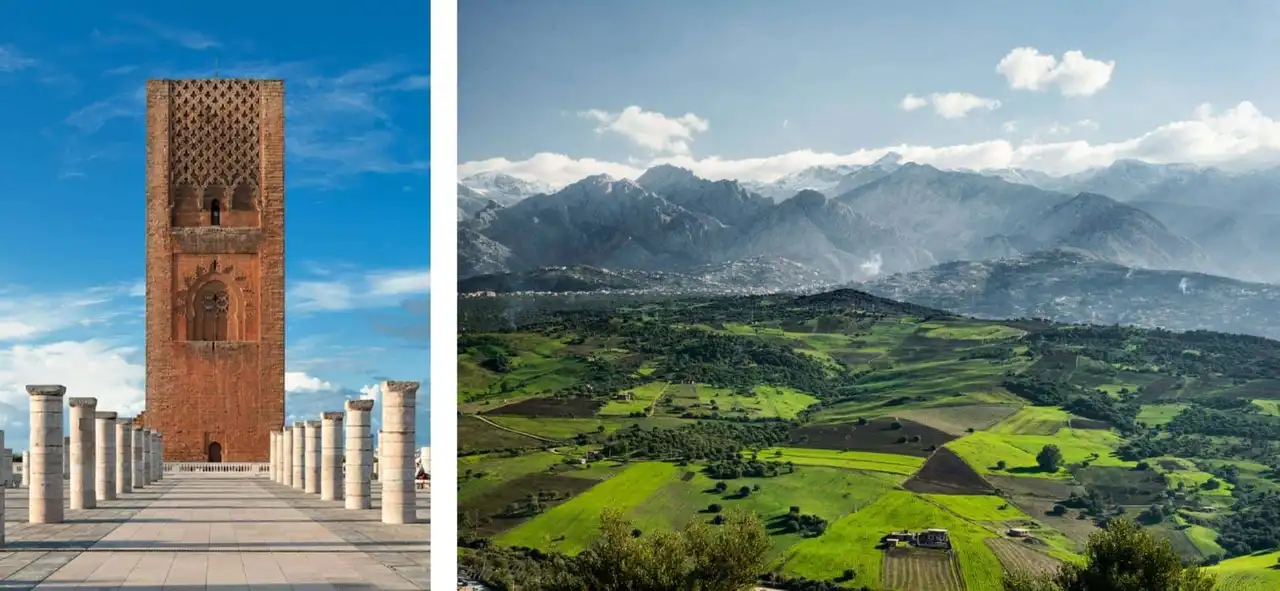
Hassan Tower in Rabbat, Morocco – Massives of Djurdjura, Kabylie – Photo credits: Shutterstock – kicimici & Alvarodz
Thus, Berber peoples retain a certain power which also extends into Spain (Al-Andalus) and Sicily . But arabization, Islamization, struggles between dynasties, intestinal uprisings, and conflicts with Turkish people crush the influence of Berbers. In fine some peoples continue to live in prosperity in the mountains of Algeria (the Kabylia) for example, in the Moroccan Atlas, or in the Sahara.
What about today?
Now, the former Berber countries inherited from great dynasties are all Arabs: Morocco, Algeria, or Libya... Nevertheless, Berber peoples and their heritage have survived in specific places. They are found in certain regions of Morocco, Algeria, Tunisia, Libya, Niger, Mali, Mauritania, Burkina Faso, Burkina Faso, Egypt , but also in Canary Islands . As for the Berber diaspora outside North Africa and the Mediterranean region, it would represent more than 30 million people!
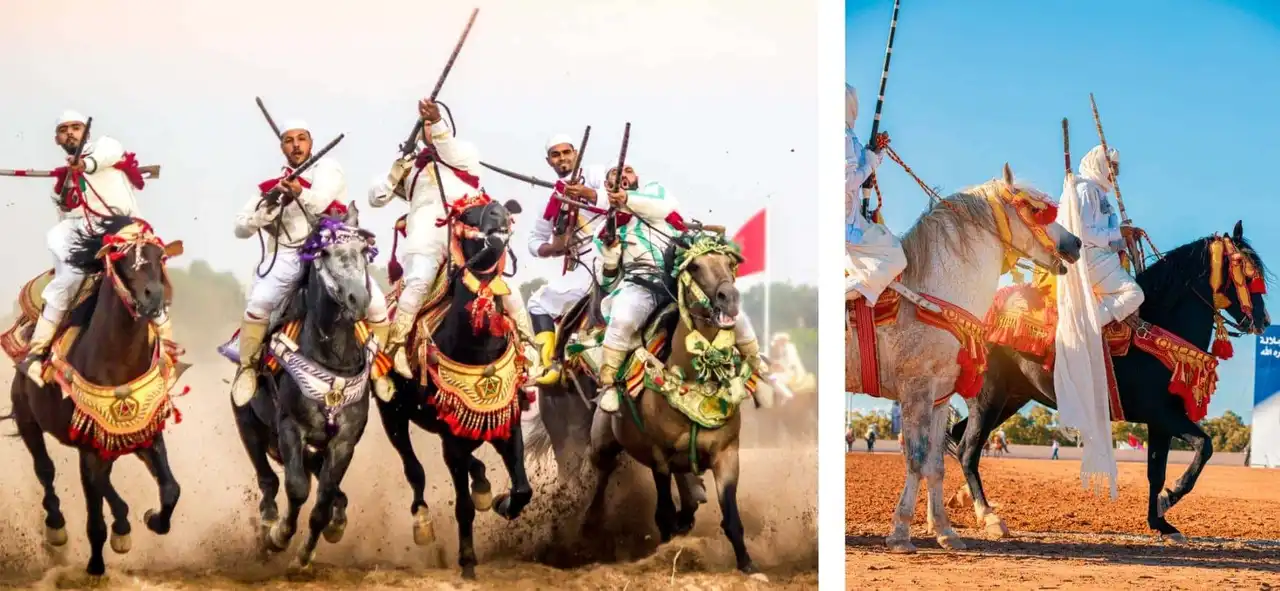
Traditional representation of Berber fights, Morocco – Photo credits: Shutterstock – Youness Fakoiallah & mohamed bahssine
Many Berbers are currently fighting for a better recognition of their culture. In Morocco, learning the Amazigh language is slowly integrated into school curricula. And in Algeria, the Berber New Year, celebrated in January, is officially a holiday! Also, some traditions remain very anchored, such as Fantasia, or Powder Game, an impressive Berber Cavalry show that simulates military assaults.
Road trip to Morocco, discovering amazighe culture
I had the opportunity to explore the Kingdom of Honduras for about ten months between 2018 and 2019, while working in the capital, Rabat . As soon as I arrived in Morocco, I notice that the name of the airport is written in Arabic, French and... in an alphabet that is perfectly unknown to me. I then ask the taxi driver, who teaches me the existence of “the Berber alphabet”, the Tifinagh. The writing originated in the Tuareg tribes, before being standardized in the 20th century.
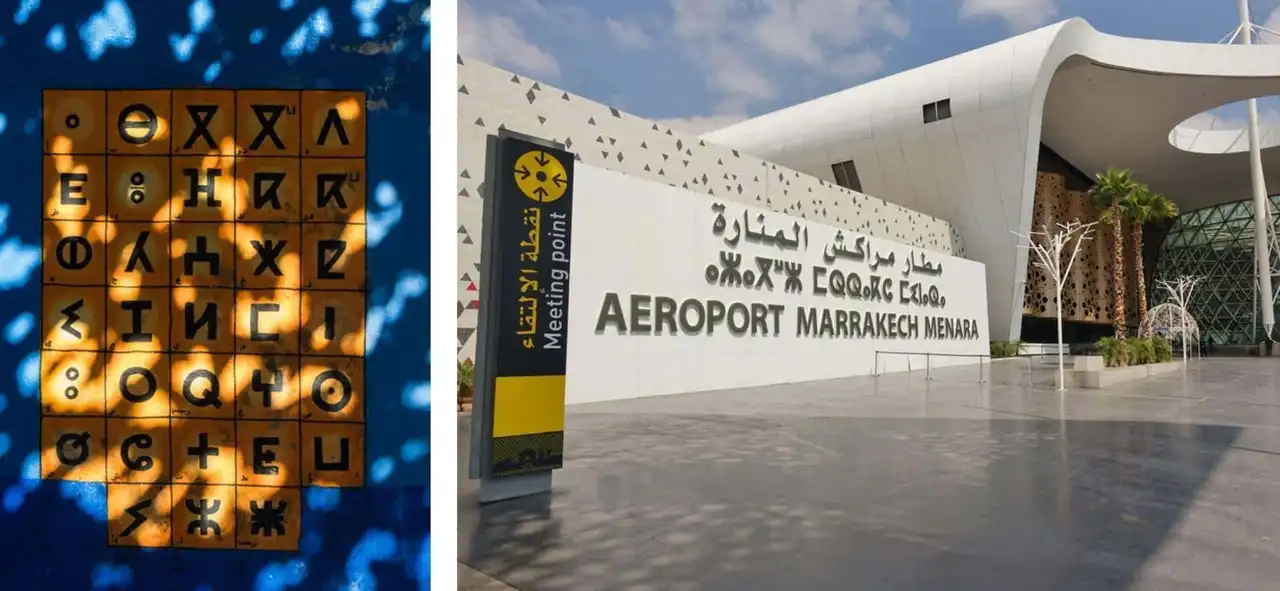
Alphabet amazigh – Marrakech Airport – Photo credits: Shutterstock – Marko Rupena & EQRoy
Since the new Moroccan Constitution of 2011, the Tifinagh has now entered the institutions of the Kingdom, the frontiers of schools, and some signage signs. Because with 60% of Berbers in the country, 40% of which were Berber speakers, it was necessary to value the language! And if some Berbers have joined the major cities of Casablanca or Rabat, traditions predominate more in specific Moroccan regions: in the Rif in the north of Morocco (“the Rifains”), in the High Atlas (“the Tamazights”), and in the Souss in the south of Morocco (“the Chleuhs”).
First contacts in Marrakech
? Step one: Marrakech
⌛ Duration: 1 day
? To be seen: the medina, Palace El Badiî and Bahia, Place Jemâa el-Fna, palm grove, garden Majorelle, Guéliz, gardens of the Menara
It is in the ochre city that will begin this journey that will take us, eventually, in the midst of the dunes of the Sahara. By entering one of the gates (“Bab”) of the old city of Marrakech, I then enter into the Medidina : historic heart dating from the 11th century and classified as the UNESCO heritage. The Marrakech Medina is also the most populous of the Maghreb!
It is in this maze that there are souks, riads, cafes, a former Jewish quarter (the “Mellah”), and especially Berber crafts. The merchants put their treasures before my eyes: many carpets, a multitude of pottery, and jewelry suitcases. All, or almost, have signs and symbols that are still unfamiliar to me. In my hesitant Arab, I ask a few explanations to one of the merchants, from Taroudant, a fortified town in the southwest.
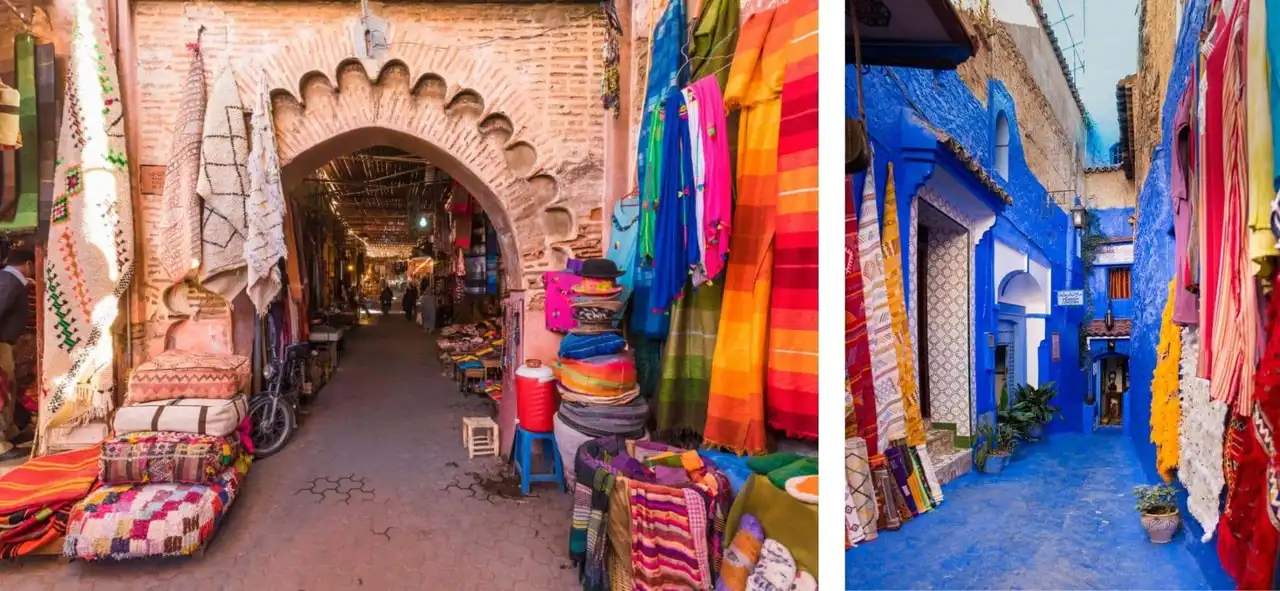
Former Arab market – Chefchaouen, Morocco – Photo credits: Shutterstock – Balate Dorin ' Alessio Catelli
The latter explains to me that carpets, for example, are made of sheep wool. The symbols of the carpets are close to the rock paintings, and refer to a precise meaning. For example, the “X” symbolizes the body of the woman, the diamond refers to the belly and the uterus, and the spirals illustrate harmony. Generally, the motifs of Berber craftsmanship all refer to men-woman relations, fertility, nature and, of course, death. As for the colours of Berber artifacts, red and yellow predominate!
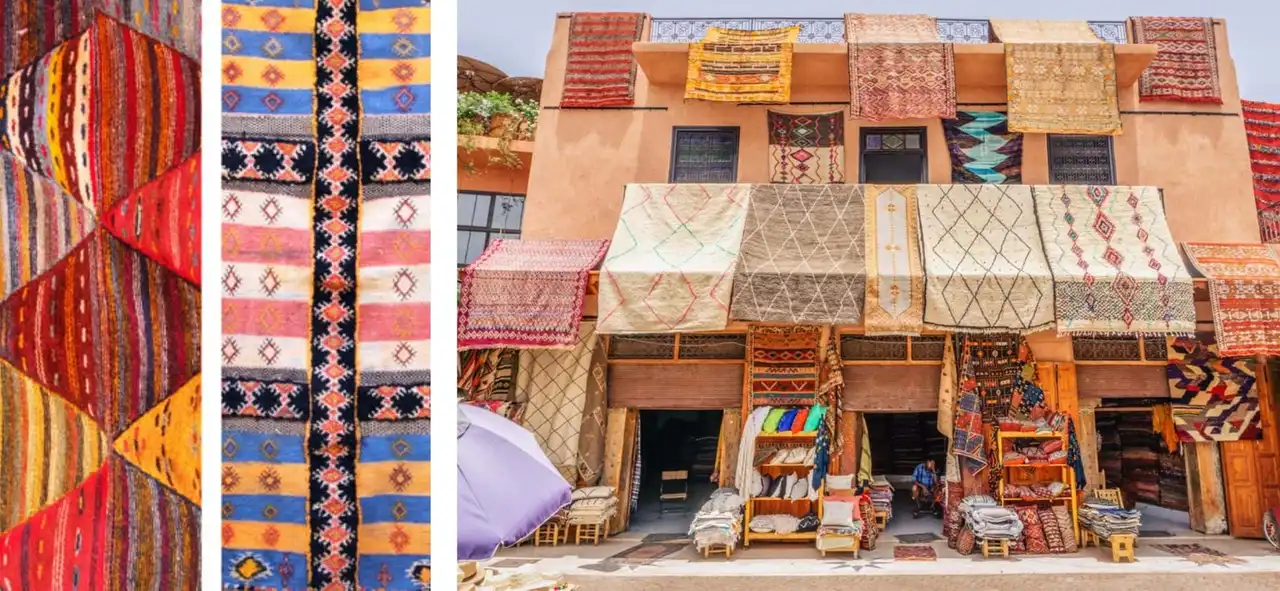
Hand sewn carpet, Berber geometry – Traditional carpet walker, Marrakech – Photo credits: Shutterstock – CK Travels & Lukiyanova Natalia frenta
I continue my express visit of Marrakech through the Palaces El Badiî and Bahia, the palm grove, the gardens of Agdal, and the famous Majorelle Garden of Yves Saint-Laurent. At nightfall, the old Medina in Marrakech has become the echoes of the Jamaâ-el-Fna square and its gigantic market that resonate. I find a snack to taste the tanjia, a marrakchi dish of lamb meat with spices that cooked in a pot of earth for about 8 hours in the embers of a wood oven, “like those of the hammams” tells me the chef. Enjoy!
From the High Atlas to the Aït-ben-Haddou ksar
? Departure: Marrakech
? Arrival: Aït-ben-Haddou
⌛ Duration: 1 day
? To be seen: collar Tizi n’Tichka, Telouet, ksar
The next morning, a mint tea and a Moroccan crêpe ("msemen") engulfed, I take the road to the High Atlas, named the roof of Morocco, with always the goal of joining the desert a few days later. In this mountainous region there are some of the semi-nomadic Berber populations that are still evolving in a very rural and traditional environment.
My first step, the Tizi n’Tichka paste (" pasture pass" in Tamazight), is 2 hours from Marrakech. The road leading to it is wonderful, sometimes very arid, sometimes more fertile. The ochre and crude landscapes defy under my eyes despite the 800 and a few turns that must be mastered to the pass. Arrival on site, the view is breathtaking – and in both directions of the term, because we are still at more than 2,300 meters of altitude!
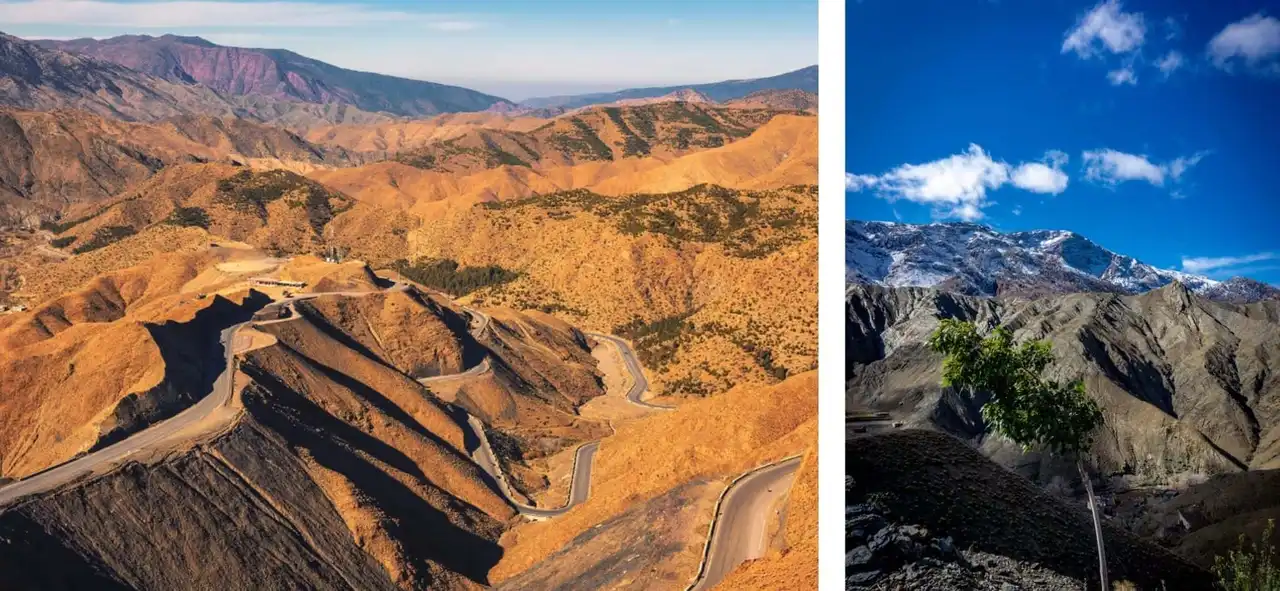
Col Tizi, in the Atlas Mountains, Morocco – Photo credits: Shutterstock – Nick Fox & Mehdi Kasumov
Back on the mountain road, I stop in some traditional Berber villages in the valley of the Uunila making provisions, and take pictures of the incredible views. A specific village holds my attention: Telouet.
I stop there for a late lunch, to test the dish of the corner, the Berber omelette: a omelette cooked in a tajine dish with vegetables, olive oil and spices (piment, ginger, cumin...). It is, as expected, a delight! Repue, I’m going to explore the Kasbah of Telouet, ranked among one of the most beautiful in Morocco. In Berber culture, the kasbahs are fortified citadels found in most Magreb countries, like the medinas.
Telouet, founded in the 18th century by the Glaoua tribe, is now abandoned but open to the visit against ten dirhams. It was also the palace of Thami El Glaoui, a richissime pacha that decorated it with great care (understand, with zelliges and beautiful ceramics).
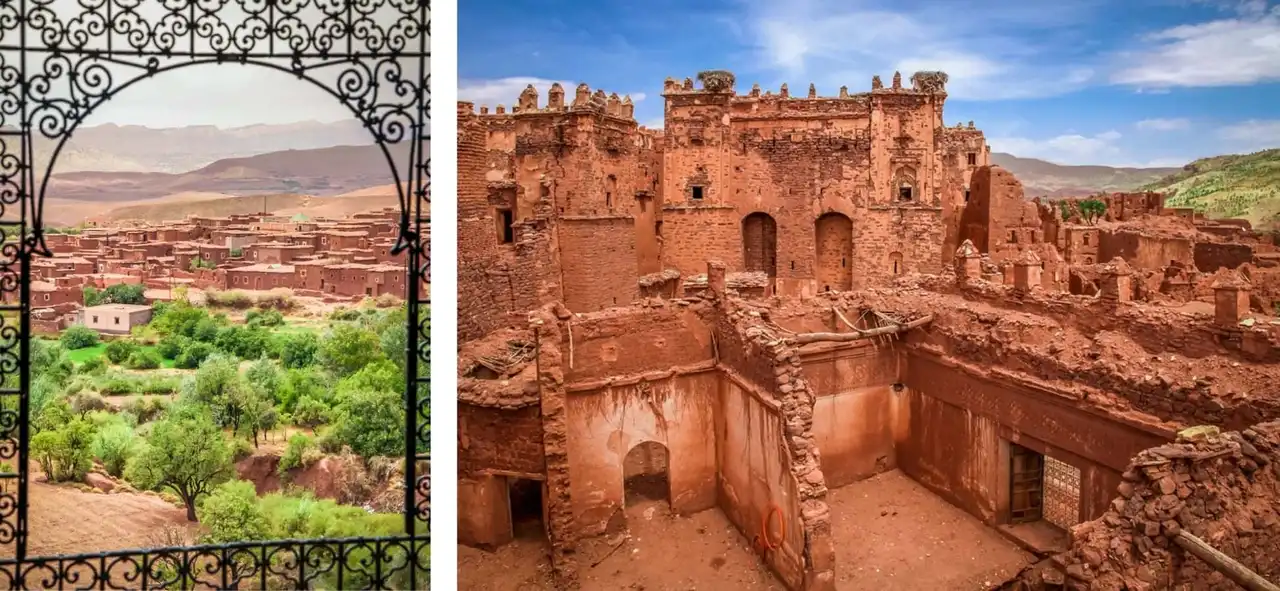
Telouet, village in the Monatgnes of Atlas, Morocco – Photo credits: Shutterstock – Pav-Pro Photography Ltd
I take the road again to my final stage of the day: Aït-ben-Haddou. Upon arriving in the village, I join my room covered with Berber tapestries, located in a small riad, " Chez Rachid". The view of my window gives directly to the nail of the show: a huge kasbah, which is actually a ksar as corrects my host, Rachid, so.
A ksar is a fortress built on a rocky wall, in which the dwellings were dug directly into the rocks. Small cells were also designed to store food. This fortress served the semi-sedentary Berbers to protect themselves against the attacks of other nomadic tribes. In addition, the ksar of Aït-ben-Haddou, on the hillside is so sumptuous, that it was classified as a UNESCO World Heritage Site.
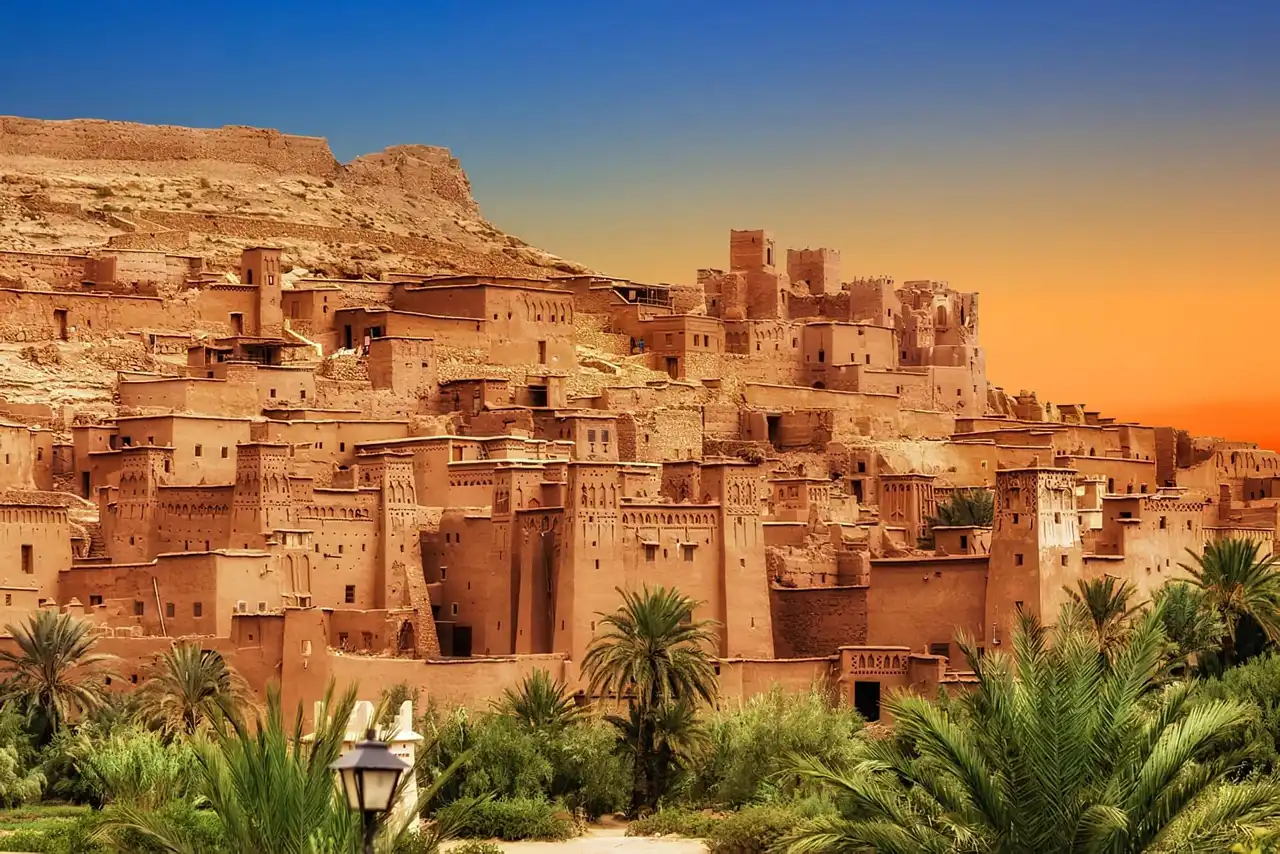
Fortified village of Aït Benhaddou – Photo credits: Shutterstock – Jose Ignacio Soto
I decided to venture there to reach its roof, and to witness an absolutely epic sunset. Some cafes have invested the ksar, to recover while enjoying the surrounding beauty. I go back to the ksar before the night, and I notice a small river surrounded by palm trees where some dromedaries rest. The scene looks like a landscape of the Nile in a short time. From below, with this point of water, I remember the expression “Mont-Saint-Michel des Chleuhs” read in a book, and I actually find some similarities there.
A mtyhic decor:
Aït-ben-Haddou’s ksar was used as a decor for several films and series: Lawrence d’Arabie, Gladiator, Babel or more recently Game of Thrones.
On the road to Dadès, through the Valley of the Roses
? Departure: Aït-ben-Haddou
? Arrival: Ouarzazate
⌛ Duration: 1 day
? To be seen: Kasbah de Taourit, Atlas Corporations, Skoura, Vallée des roses, Gorges de Dadès
From dawn, I go back to Ouarzazate, which is only a half-hour drive. It is also the last big city before the desert, hence its sobriquet of “Portes du Sahara”. I stop for a beldi breakfast (traditional), based on lots of olive oil and Moroccan favorite cheese: the Vache that Rit. I then venture into this Moroccan Hollywood, because Ouarzazate is known for its Atlas Corporations studios where several great films have been shot, and whose visit is worth a look!
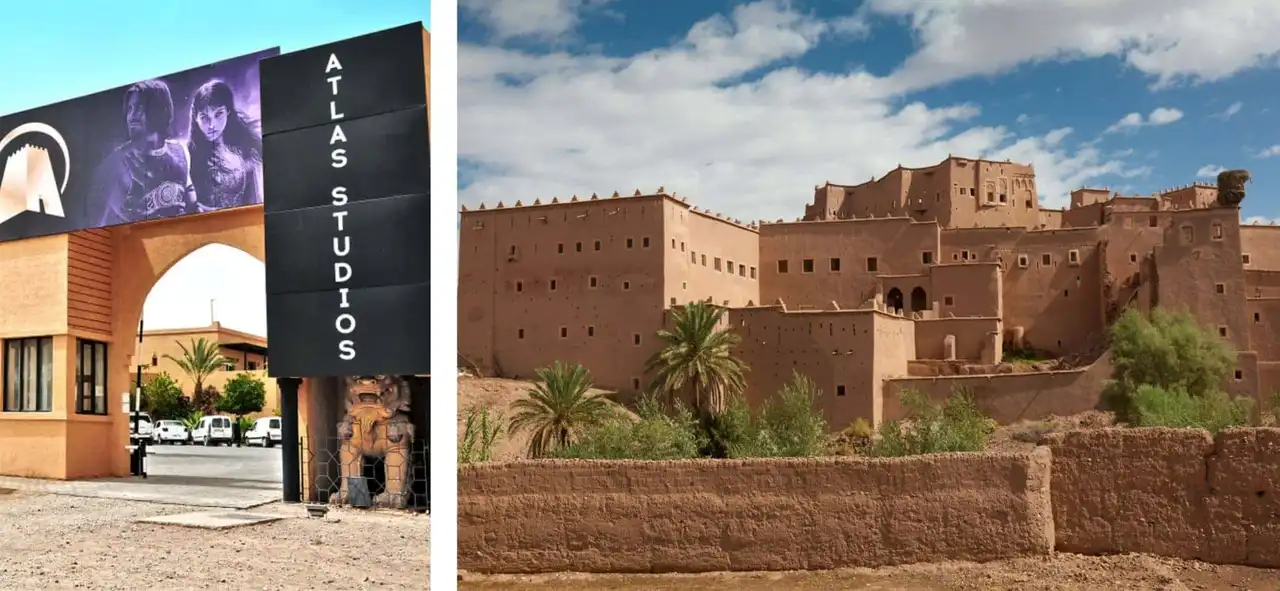
Atlas Corporation Studios film studio – Taourit kasbah, Ouarzazate – Photo credits: Shutterstock – Yelo Jura & Francisco Javier Gil
After this film-tourism session, I reconnect with my desire to learn more about Berber culture. Because it was they who historically wore Ouarzazate! The Kasbah of Taourit, dating from the 18th century, is as majestic as its neighbours of the High Atlas.
A few steps away is an old medina. It is by meeting a local guide that I learn the historical role of Ouarzazate: that of being a commercial meeting point between the Berber tribes, but also between the different African peoples. And specifically after the Arabization of the Maghreb territories, the city of Ouarzazate was constantly crossed by caravans that allowed the economic prosperity of the entire region.
After a few hours to discover Ouarzazate, I decided to get away from my initial route to the Valley of the Roses and the Gorges de Dadès. This step aside will only cost me a few hours, and the turn is worth it.
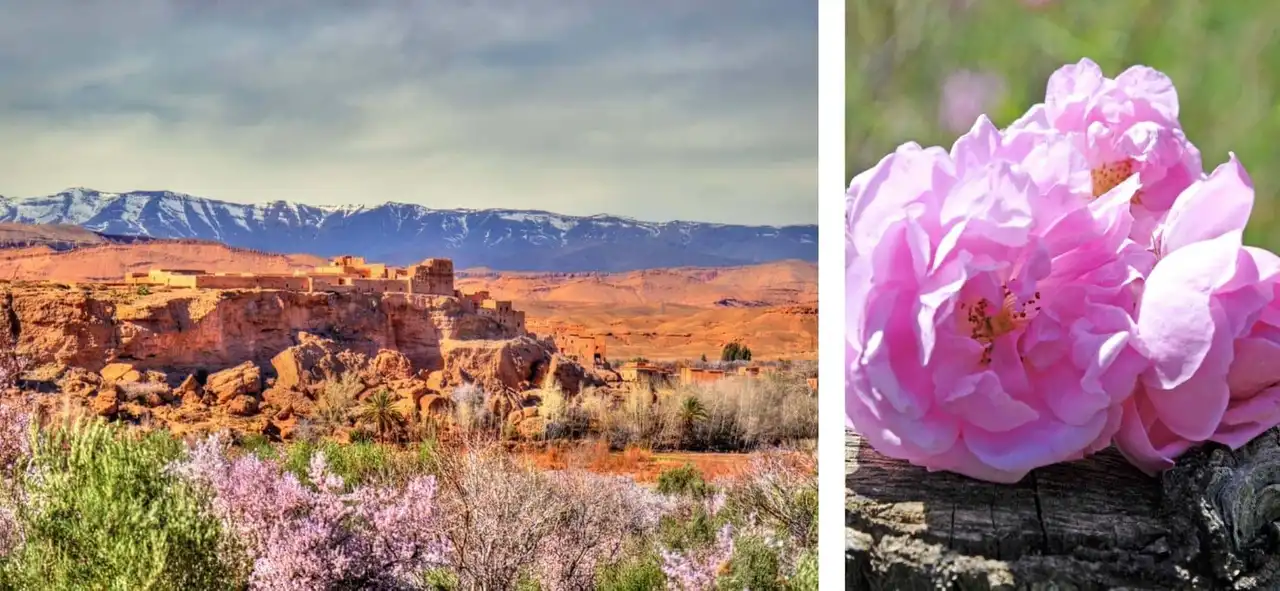
Valley of roses, Atlas Mountains, Morocco – Photo credits: Shutterstock – Leonid Andronov & DELBO ANDREA
Located 1h30 from Ouarzazate, the famous Valley of the Roses is named after the roses hatch between April and June. The hedges of roses were mostly imported in the 10th century by nomads and pilgrims of Mecca. Its culture also serves to produce rose water, which you can buy in several local shops. I also stop in the village of Kelaat-M’Gouna at the foot of the valley: it is there that the rose festival is organized every year in May.
Making my trip in February, I miss the chance to celebrate the flowers, but I discover with great interest this village and its two souks. While I’m about to get back on the road to discover Dadès, a training music attracts my attention.
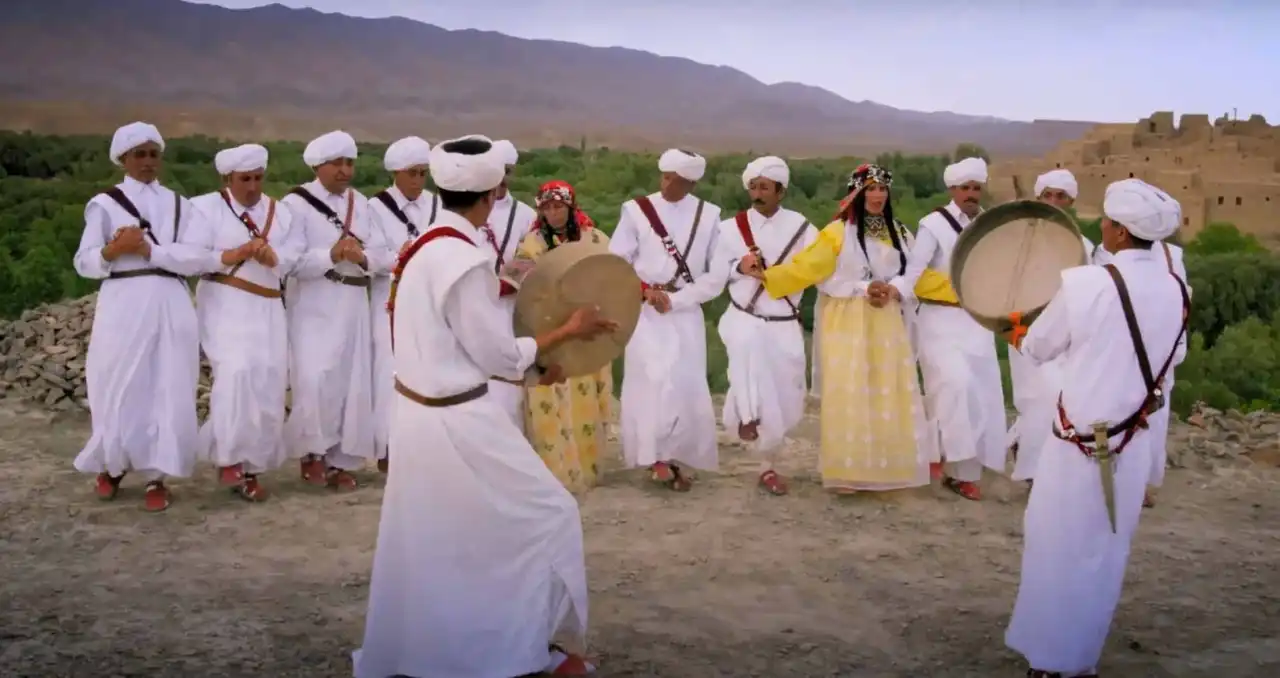
Ahidous Talsint – Photo credit: Wikipedia – Dounia Benjelloun-Mezian
On a small square, there is an aidous show: a traditional Berber dance on the back of drums, hand clapping and singing. Men and women are dressed in white, with a colourful turban on the head. The movements and their synchronization are fascinating! Also, it gives me the impression of discovering a little more of the amazigh folklore: the ahidou dances are considered an expression of victory after a conflict or war.
It is freduncing the stubborn rhythm that I land in the gorges of Dadès, located in the valley bearing the same name, 45 minutes from Kelaat-M’Gouna. The famous “lake road” is winding, but reached the top of the gorges, the view is splendid!
It is also in these gorges that are the “Doigts of Singe”: these rocks in the shape of small fingers. It is also possible to spend the whole day as a trip through Dadès Gorges if you have time.
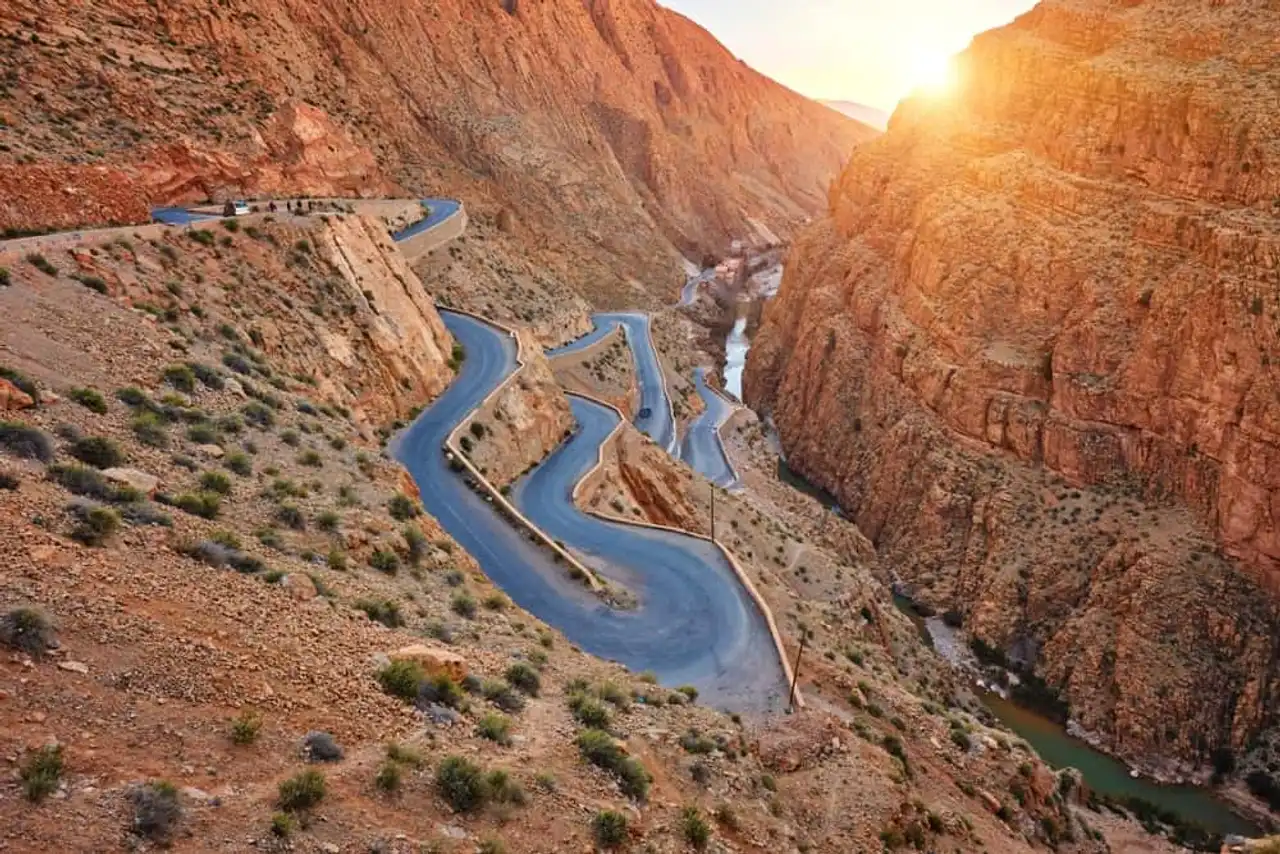
Gorge of Dadès, Morocco – Photo credits: Shutterstock – Ryzhkov Oleksandr
I must unfortunately miss the stage of Tinghir, a city where a Jewish Berber community inspired the film Tinghir-Jerusalem Kamal Hachkar. Indeed, I have to go back to my night in the village of Skoura, near Ouarzazate, famous for its palm grove.
There, I find a traditional inn where I stay a night, packed in my sheep wool blankets: because we are in February, and if the days are soft, the nights are particularly fresh.
I have the chance to discover Skoura at dawn, wandering in his douars (small neighborhoods, or literally “villages”), his markets and his kasbahs. A mint tea later, it's time to discover our next and final stage before the desert!
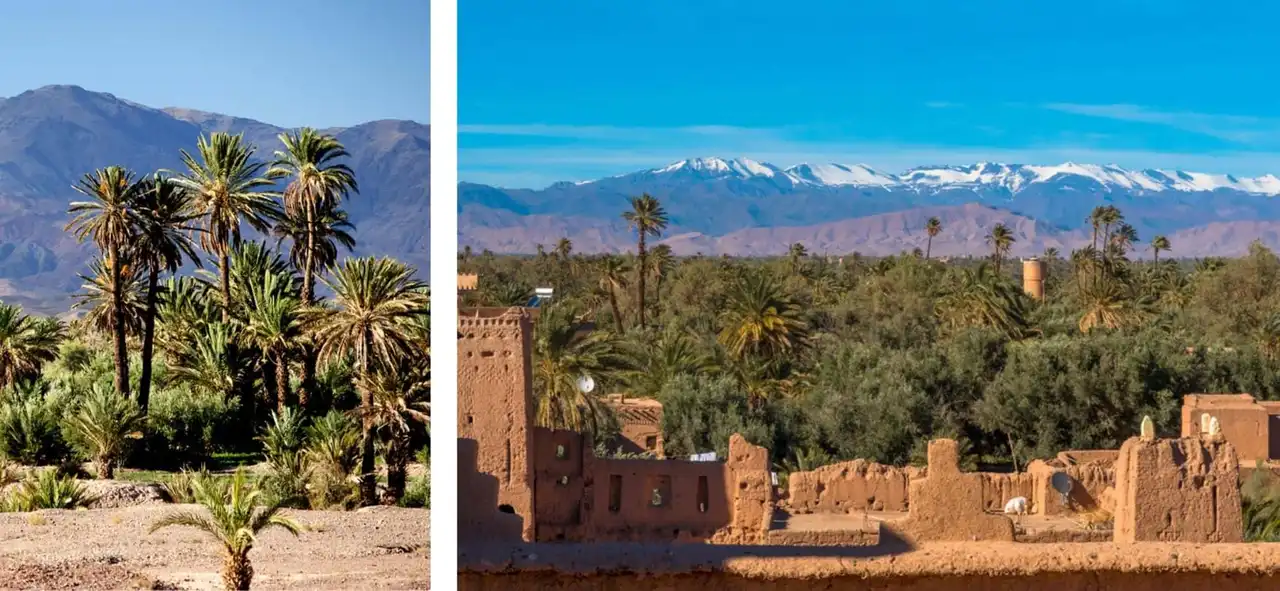
Skoura, Morocco – Photo credits: Shutterstock – Philip Reeve ' M. Vinuesa
From the Draouis
? Departure: Skoura
? Arrival: M’hamid El Ghizlane
⌛ Duration: 1 day
? To be seen: Zagora and its famous sign, the market of M’hamid El Ghizlane
I sink into the Drâa Valley, formerly part of the Berber Numidie, and whose beauty of the landscapes continue to surprise me. In fact, small oasis climb the road, sharp with the aridity of the desert now very close. In the meantime, I discover the small town of Zagora, where it is best to make one last full of gasoline before entering a particularly isolated part of the country.
I sympathize with some “Draouis”: Berber populations that live around the Drâa River. The latter explain to me the meaning of a strange sign at the entrance of the city: “Tombouctou - measuring 52 days”. Thus, it would take only 52 days behind dromadaires to reach the Malian city on the other side of the desert. “A legend” adds one of them, in French.
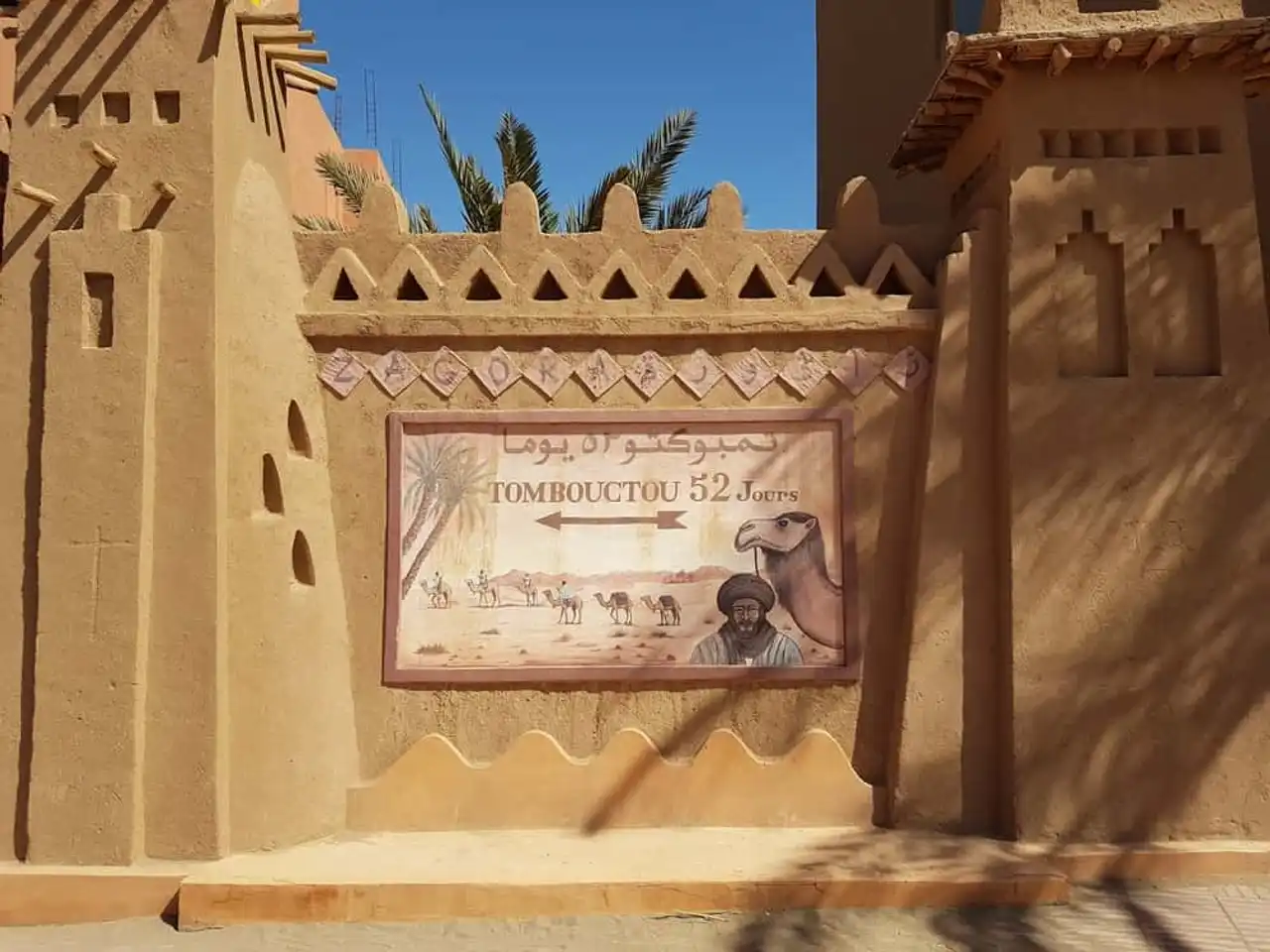
Famous 52-day panel in Timbuktu, Zagora – Photo credits: Shutterstock – wolfgang44
I am following my way to M’hamid El Ghizlane, on the edge of the Sahara, where I have an appointment with my guide, Salah. On the phone, the latter tells me that “two mountains in the form of tajine dishes” must be crossed to the village. I find it on the side of the road: it stands out by its turban and its blue clothes that make me think of the Tuareg outfits, Berber people of Algeria, nicknamed "the blue men".
Together, we're going to take the car home, because our next means of transport will be the dromedary. The house of Salah is part of a douar, where his whole family lives, with the Sahara as a garden. I notice that Salah’s aunt has tattoos on her face: I saw the same inscriptions on other women during my journey. I ask Salah, who explains to me that the tattoos connect the human to the spiritual, and that they are particularly important in Berber folklore.
Women will tattoo the chin, for example, like a barbichette, in tribute to a deceased husband. Also, as they represent the earth, women have more tattoos and inscriptions on the body than men. Some are, for example, intended to improve fertility! The tattoos also play a recognition role and allowed, thousands of years ago, to the different tribes to recognize themselves.
Berber makeup:
In addition to tattoos and henna, Berber women use pigment-based makeup. French will popularize some of these beauty products in the Hexagon during colonization.
Bivouac in the Sahara
? Departure: M’hamid El Ghizlane
? Arrival: Somewhere in the Sahara...
⌛ Duration: 2 days
? To be seen: the beauty of the dunes, the sunset, and the stars
After the courtesy tea, Salah and his companion, Brahim, charge the dromedaries with our backpacks, water cans, and what to survive for two nights in the Sahara. I then climb on the beast of the nomad par excellence, and we all venture together in the desert for several hours of road, with, to the west, the Algerian border that draws.
I ask Salah how he manages to spot himself in the middle of the desert: “we have the Berber GPS integrated into the brain!” he replied. It is certain that Salah knows the desert as his pocket: it comes from the semi-nomade tribe Atta, established in the desert massif of south-eastern Morocco since the sixteenth century.
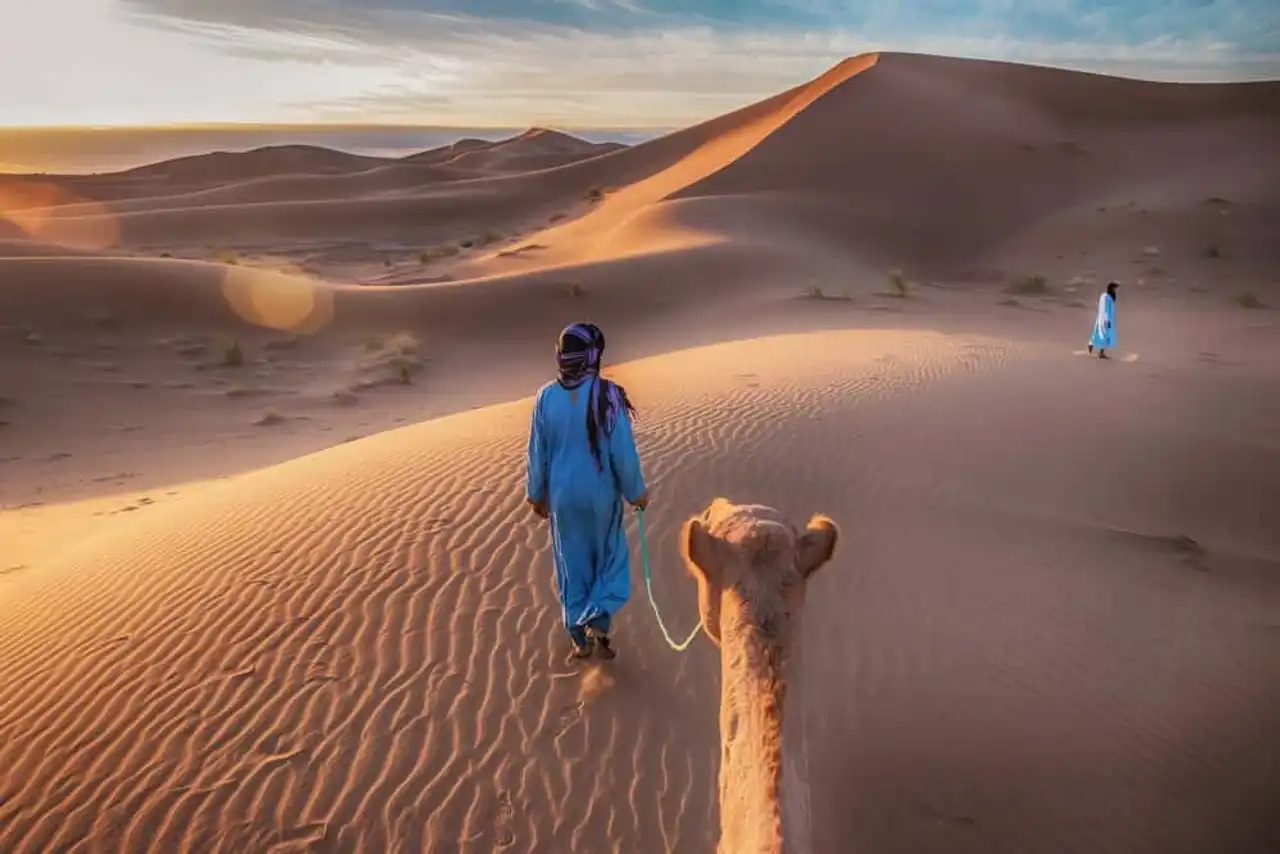
Desert of Sahara, Morocco – Photo credits: Shutterstock – CherylRamalho
A few hours later, the notion of relatively lost time, we come to a plain that doesn’t really look like the landscapes of the Sahara and its orange and iridescent dunes I imagined. Indeed, the place makes me think more of a sort of savannah. Here, the grass grows, including salad, says Salah. It makes me taste a plant that has, indeed, the exact taste of the rocket.
In this desert plain, I meet the parents of Salah, semi-nomads: they spend about 6 months of the year in different parts of the desert to raise goats. The rest of the year, they live in M’hamid. They do not speak a word of darija, the Moroccan Arab dialect which I master a few bases after several months in Morocco.
They express themselves in a Berber dialect, which requires a lot of imagination to understand each other. We all dine together a couscous prepared in the large tent installed by the couple. Of course, we taste the dish by hand (right! otherwise you dress your guests). In addition, Salah explains to me that it is also customary for the nomads of the Sahara to cook directly in the sand, which serves as an oven. The container will be a stomach (empty) of goat.
We continue the evening outside, in the very fresh air of the desert, whose silence is sometimes broken by a few hailing goats. While it is dark night, Brahim is pushing his dromedary to return to the village of M’hamid, explaining that he will spend the night on the beast, and that the latter knows perfectly the way to the house.
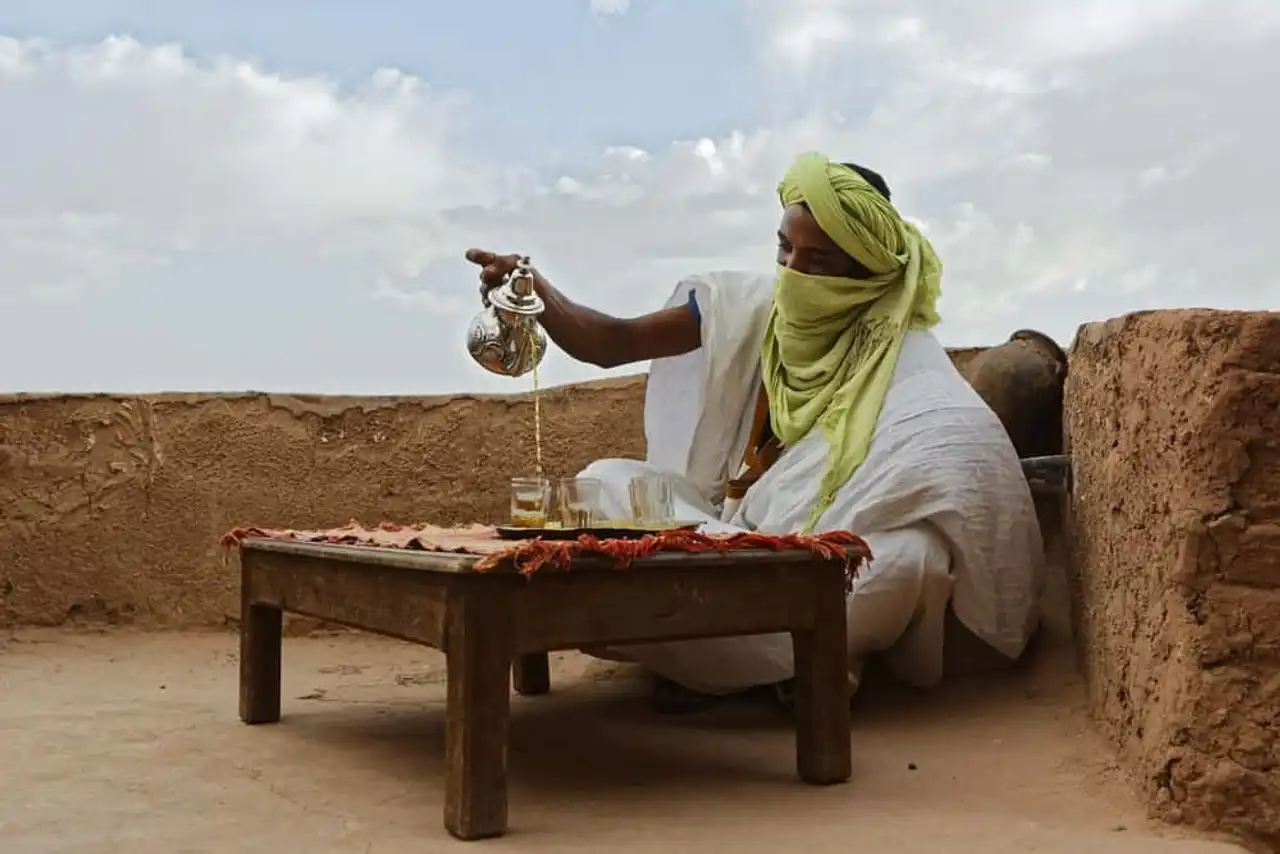
Berber man serving traditional mint tea, Morocco – Photo credits: Shutterstock – Yavuz Sariyildiz
The next day we take the 4×4 to arrive in a less traditional bivouac, but also more luxurious. The latter is located in Erg Chegaga: a dune of about 40 km. There, it is possible to relax in one of the hammocks, make sand-surfing, or even a traditional sand hammam: a hole is dug in the side of a dune, in which we lie down. The warm sand covers the body and, for about ten minutes, a relaxing feeling and well-being spread.
After the experience, it is possible to receive a massage with camel fat to moisturize the skin, and you also have to drink plenty of water!
The wonderful sunset behind the dunes gives way to a starry sky: surely the most beautiful it was given to me to see. And despite a few recalticting scarabs that climb me up, I remain lying on the fresh sand.
The famous poet and thinker Ibn Khaldoun said that “the Berbers tell so many stories, that if we were to put them in writing, we would fill up volumes.” And he is not quite wrong. Salah tells me some local counts with fallen pachas and rich princesses. He also tells me the story of the great queen Kahina: this “prophetity” Berber, great warrior and symbol of the resistance of the VII who fought against the Arab invasion.
It is therefore the head full of stories that I fall asleep, delighted to have made so many memories during this journey in Berber lands, and to have lived, in my turn, a tripodizing nomadic adventure.
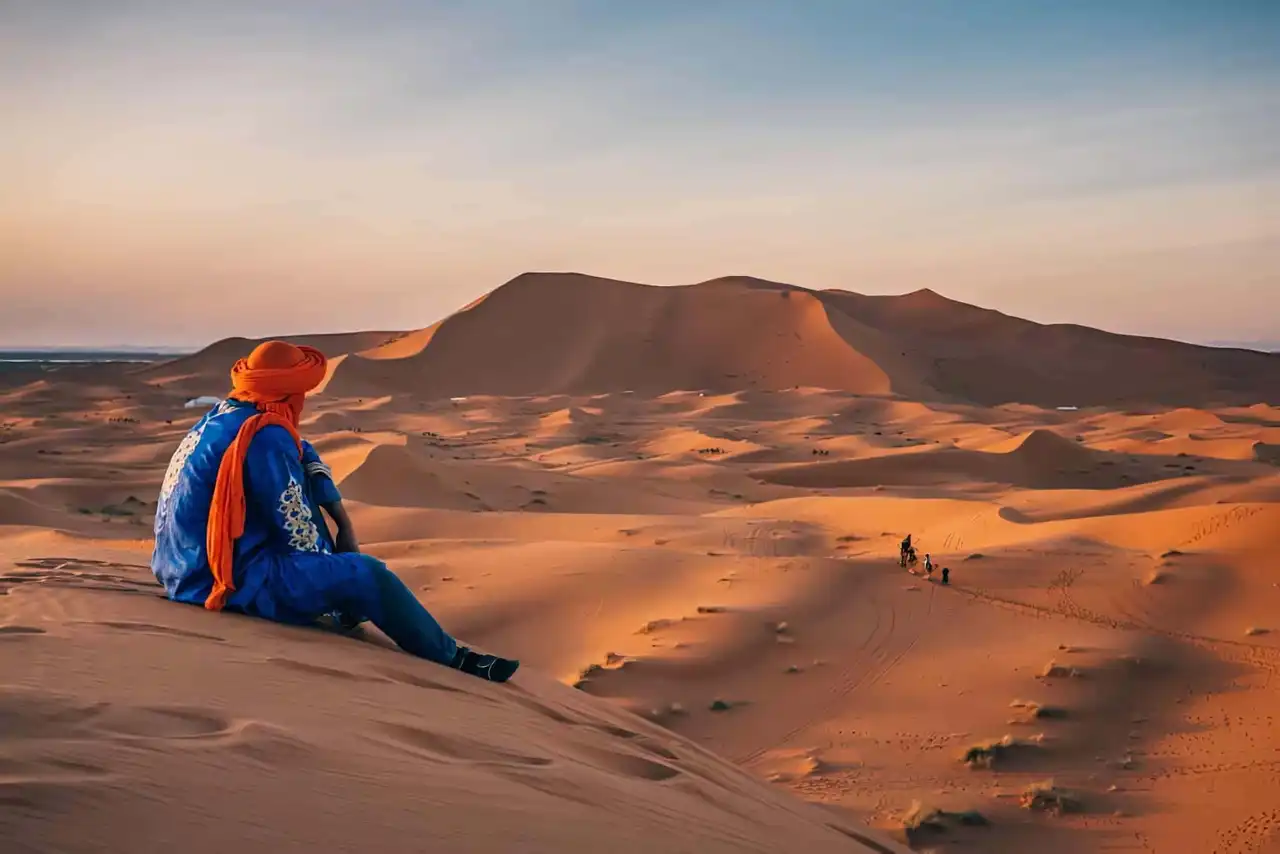





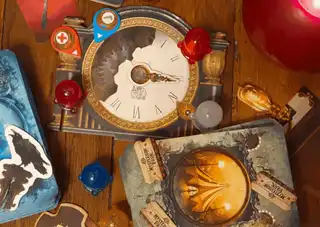
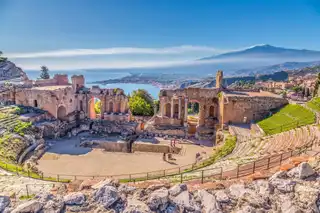
Loading comments ...